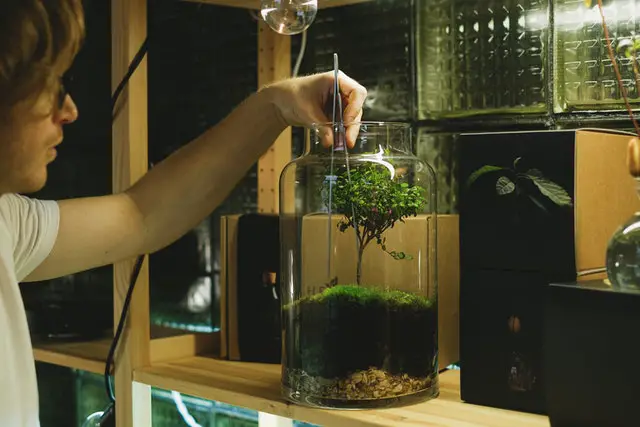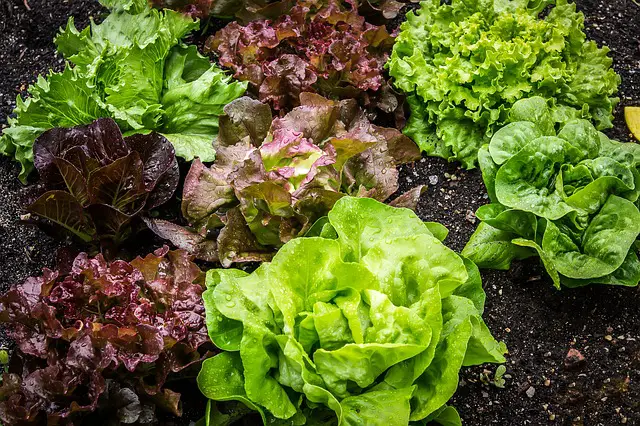Have you ever wondered what it felt like to invite nature’s full glory into your living space? You may have been a fish or plant parent, but why can’t you be both? Understanding the intricacies of mason jar aquaponics can bring you the joys you seek.
With mason jar aquaponics, you can create a stunning and self-sustaining ecosystem right in your own home, providing a unique and rewarding way to connect with nature and learn about the delicate balance of life.
And what’s more? This article eases you into becoming a mason jar aquaponics pro. All you need do is stick to the piece to the end and follow the littlest details of each step.
You may also have questions about growing plants and fish in a mason jar. No worries, we have also thrashed the frequently asked questions we encounter.
Understanding Mason Jar Aquaponics

From biology, we learn that the end product of photosynthesis is oxygen, and plants require carbon dioxide to synthesize food. So, mason jar aquaponics involves creating an ecosystem for plants and fishes where they both benefit from their micro-environment.
The fish waste and carbon dioxide from respiration are sources of manure and food for plants. This way, the plants clean up the debris and help the fish maintain a conducive living condition.
1. How it Works
Like commercial aquaponics, mason jar aquaponics creates a symbiotic ecosystem for fish and plants. The difference, however, is that it uses a glass jar as the environment and can only hold a single plant.
The glass jar can contain at least a liter of water and grows beta fish instead of carp or tilapia.
2. Plant Types Suitable for Mason Jar Aquaponics

Several factors endear you to mason jar aquaponics. Yet, to enjoy this process, you must introduce the right plants into your micro-environment. These plants include:
- Coriander
- Lettuce
- Tomatoes
- Spinach
- Basil
- Kale
The plants in this environment are usually leafy greens, veggies, and herbs. This is because they are friendly to fish and do not require ample water space. These also do not have extensive nutrient requirements and do well in mason jar aquaponics.
3. Aquatic Animals that Grow Well in Mason Jar Aquaponics
Besides beta fishes, you can grow tilapia and barramundi fish in mason jar aquaponics. These freshwater fish can adapt to all environments, making them easy parts of your aquaponics garden. You can also grow trout, snails, and shrimps as part of your aquaponics garden.
How to Grow Plants Using Mason Jar Aquaponics
To successfully create an appropriate environment for both inhabitants of the mason jar, you must include all essential components and conditions of living.
1. Materials Needed

You will need the following items to construct a mason jar environment:
- Air stones
- Betta fish
- Plant seedling
- Large glass jar
- Decorative gravels
- Water conditioner
- Net pots
- Growth medium
2. Planting Procedure
This includes the preparation of the glass jar and the acclimation of fish and plants to the micro-environment. Set up the mason jar aquaponics in these steps:
- Select a glass jar that can hold an average of one liter of water. It must also be wide enough at the rim to hold a net pot
- Clean the jar thorough to ensure that it does not hold contaminants
- Place the decorative gravels at the bottom of the jar
- Fill the jar with just enough water to leave an inch of air at the glass top
- Pour an equal volume of water conditioner into the water
- Acclimate the fish before introducing them into the water
- Allow the fish waste to build up before putting the plants. This is necessary because fish waste becomes plant food.
- In transferring the plant from the soil, you must clean up the soil debris thoroughly off the plant roots
- Ensure that the plant growth media covers the entire net pot evenly to allow for maximum nutrient absorption
- Put the net pot on top of the glass jar
- Set this mason jar in a location that allows sufficient amounts of sunlight
3. pH Control in Mason Jar Aquaponics
You are bringing two different life forms together in a closed environment. So, you must be mindful of their growth conditions. An important factor is the level of acidity of the environment. This is tricky as there are three life forms in this environment – bacteria, plants, and fish. So, to balance this, you must keep a neutral pH of 6.8 to 7.2 in your mason jar garden. If the environment is on either extreme, the life forms in the garden will do poorly.
The fish waste contains high levels of uric acid. This can pollute the water and cause it to become acidic. So, you must monitor the water pH level daily and keep it neutral.
Advantages of Mason Jar Aquaponics

Some of the benefits of mason jar aquaponics include:
- Aquaponics lets you grow fish and food at the same time. It cuts down expenses and growing
- There is no need for plant fertilizers as the fish provide manure
- In this environment, there is also no need for pesticides or other chemicals
- You can grow food in a small environment and record excellent yield
- The food from mason jar aquaponics is healthy and organic, without hazardous chemicals
- This system is environmentally friendly, and there is no waste in production. This is because the plants utilize the waste from fish as manure, and the fish use oxygen in respiration.
Benefits of Mason Jar Aquaponics for Indoor Gardening
Mason jar aquaponics offers numerous advantages for indoor gardening enthusiasts. Beyond the aesthetic appeal, this system provides a sustainable and self-contained ecosystem that allows you to grow both fish and plants simultaneously.
By eliminating the need for external fertilizers and pesticides, mason jar aquaponics promotes organic and chemical-free food production. Additionally, the compact size of the mason jar setup makes it ideal for small spaces and urban dwellings, enabling anyone to experience the joys of gardening, regardless of their living situation.
With this system, you can have a lush indoor garden that not only beautifies your living space but also provides you with fresh and nutritious produce throughout the year.
Pro Tips
To record success in mason jar aquaponics, here are a few tricks to employ:
- Feed the fish sufficiently with nutritious feed. Most fish resort to feeding on the weak fish during starvation. To avoid depletion of the fish stock, feed them adequately
- Provide good aeration in the micro-habitat. All life forms need a good oxygen supply to thrive. As the fish grow, they may need an increased level of oxygen in the water
- To avoid toxicity, remove excess fish waste and keep the environment clean at all times
- Pick plants that have similar water conditions as the fish for the mason jar aquaponics
- Have an extra source of light supply
Maintenance and Care Tips for Mason Jar Aquaponics
Maintaining a healthy and thriving mason jar aquaponics system requires proper care and attention. To ensure optimal conditions, regular monitoring of water quality parameters such as pH, ammonia, nitrite, and nitrate levels is essential.
It’s also crucial to establish a balanced feeding regimen for the fish, providing them with a nutritious diet that meets their dietary requirements without overfeeding.
Additionally, maintaining adequate oxygen levels through proper aeration and ensuring the removal of excess fish waste will help prevent water pollution and maintain a clean and conducive environment for both fish and plants.
Regular pruning and harvesting of the plants will promote growth and prevent overcrowding, allowing for better nutrient uptake and overall system health. By following these maintenance and care tips, you can enjoy a thriving mason jar aquaponics system that provides you with fresh produce and a beautiful display of aquatic life.
Troubleshooting Common Issues in Mason Jar Aquaponics
While mason jar aquaponics is a relatively straightforward system, some common issues may arise that require troubleshooting. One such issue is the occurrence of algae growth, which can negatively impact the system’s balance and hinder plant growth.
Implementing strategies such as reducing light exposure and maintaining appropriate nutrient levels can help control algae growth. Another common problem is fish health issues, including diseases or stress-related symptoms. It’s important to closely observe fish behavior, maintain proper water quality, and promptly address any signs of illness.
Additionally, plant-related issues such as nutrient deficiencies or pests can occur in the mason jar aquaponics system. Conducting regular inspections, providing appropriate nutrient supplementation, and implementing pest management techniques, such as introducing beneficial insects, can help mitigate these problems.
By being aware of these common issues and their potential solutions, you can effectively troubleshoot and maintain a healthy and thriving mason jar aquaponics system.
Summary
This article has captured all you need about mason jar aquaponics. With this, you can successfully build the best aquaponics garden and harvest healthy foods with little or no stress.
It also gives you the advantage of learning the beauty of the plant and animal kingdoms and creating mutualism in the comfort of your home.
Frequently Asked Questions
What are the advantages of aquaponics?
There are numerous benefits of aquaponics, as stated in the article. These include efficient nutrient utilization, affordable and healthy farming, and aesthetics.
Mason jar aquaponics also creates a safe environment for plant and fish growth. This eliminates threats such as pests and diseases within the controlled environment.
What can you grow in an aquaponic system?
Freshwater fish such as beta and tilapia fish do well in this system. Other aquatic life like water snails, trout, and shrimps thrive in the aquaponic system. Vegetables and greens are the most used plant life in this system.
How does aquaculture help in gardening?
The waste from fish becomes manure for the plants, and it saves the cost of fertilizer. It is also safe as organic food does not contain harmful chemicals. Also, you can grow greens in a controlled environment. This reduces the risk of failure.
What is the pH of an aquaponic garden?
The pH of the aquaponic garden is neutral. It is best to maintain a pH between 6.8 to 7.2. This supports all the life forms within the environment.
Conclusion
Mason Jar aquaponics is an intriguing and refreshing form of gardening. It is best for perfectionist gardeners who want control over their garden’s micro-environment. It eliminates most of the rigors of gardening in the soil and utilizes elements within the micro-environment to sustain the fish, bacteria, and plants.
This article has concisely explained all that you need to know and will serve as a guide on your journey into mason jar aquaponics. You can also delve into the intriguing land of gardening and learn to be a garden pro.

Hey, I’m Lisa and I’ve been an avid gardener for over 30 years. I love writing, talking and living in the garden! Feel free to connect with me on my socials below
